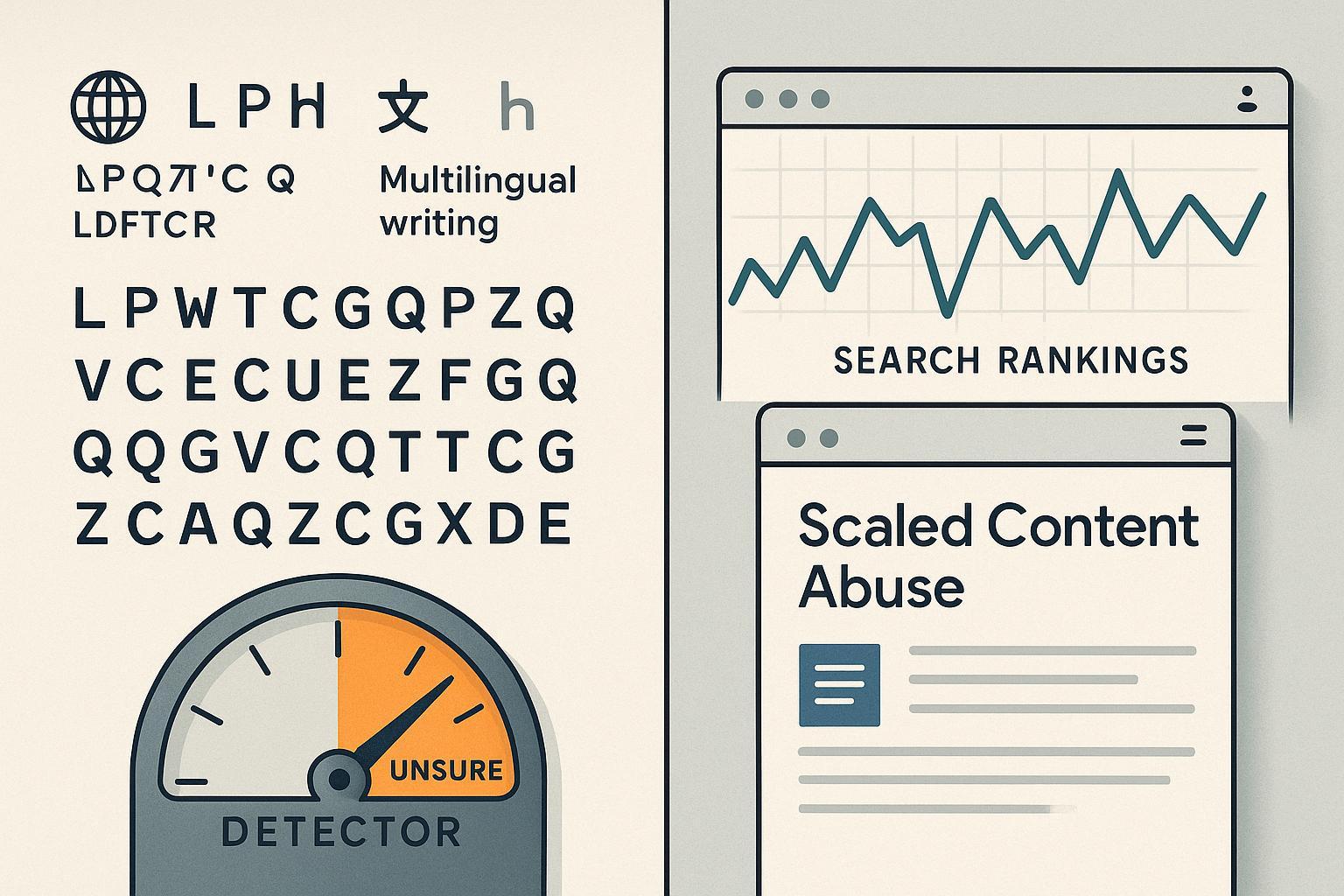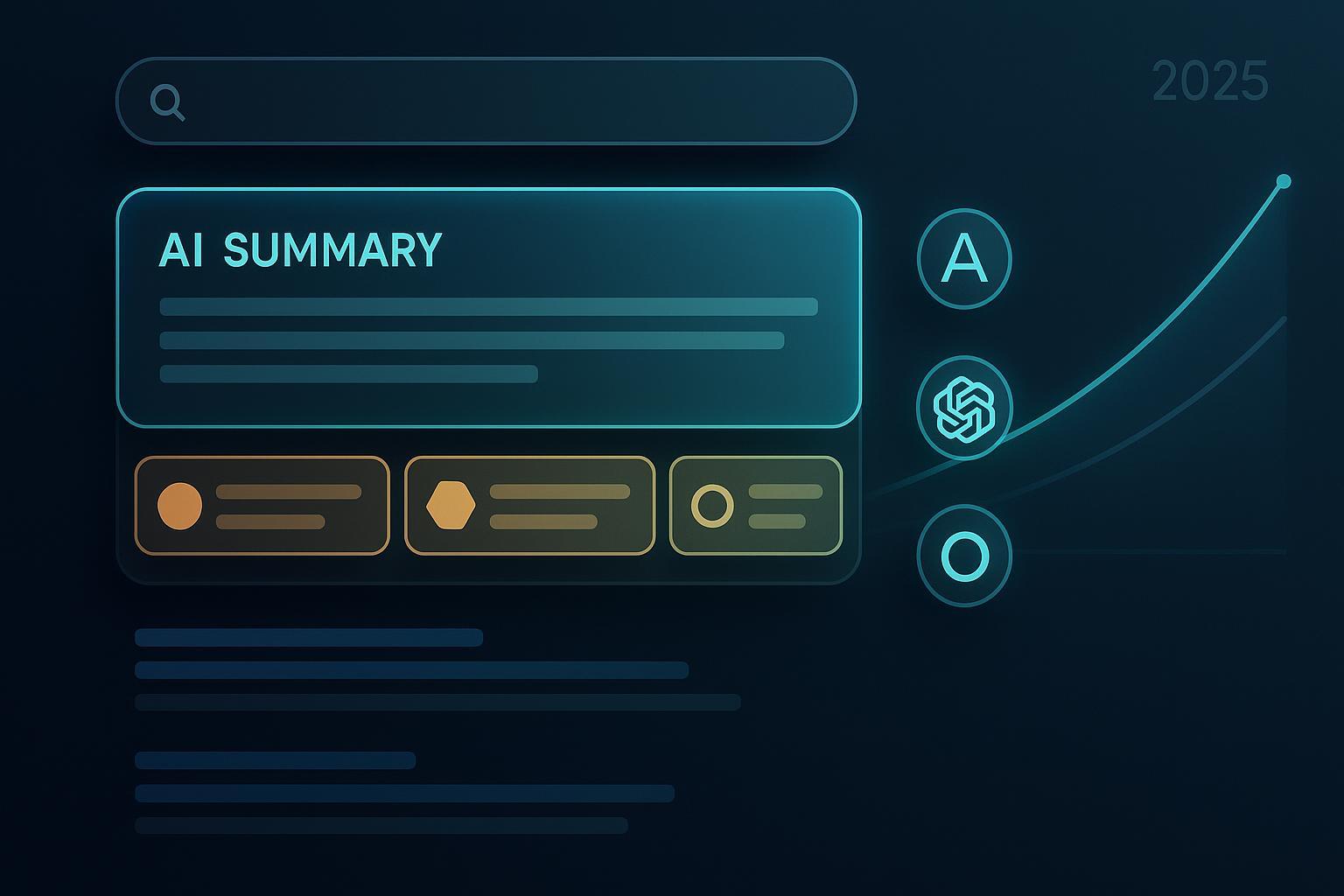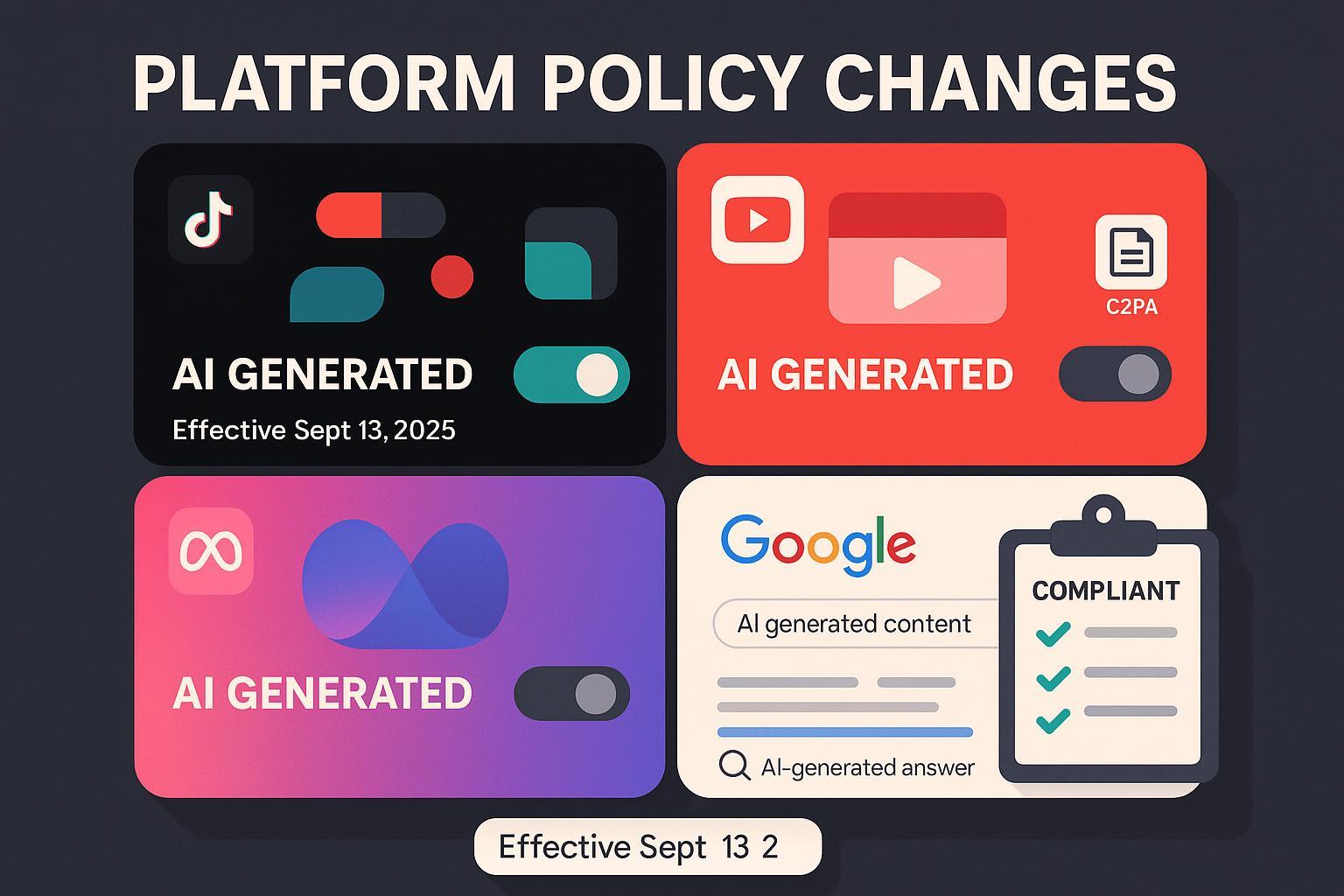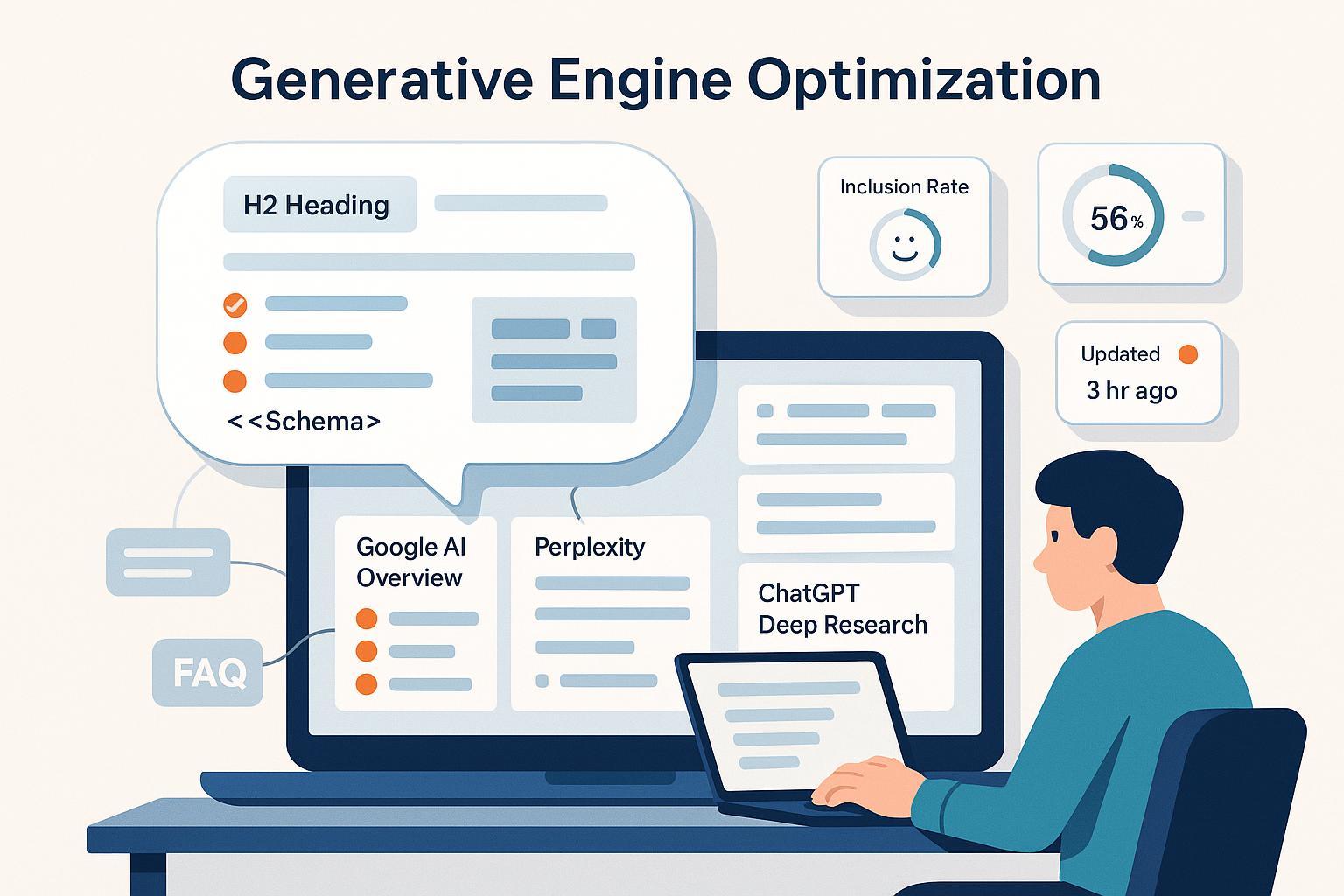AI-First Content Strategy: The Ultimate Guide to the Future of Search
Discover the complete guide to AI-first content strategies for Google, Bing, ChatGPT, and Perplexity. Boost visibility and earn citations—read actionable steps now!


Modern search doesn’t look like ten blue links anymore. AI systems summarize, cross-check, and cite sources directly on the results page. That shift changes how your content is discovered, trusted, and clicked. This guide shows you how to build an AI-first content strategy that works across Google (AI Overviews/AI Mode), Bing/Copilot Search, ChatGPT Search, and Perplexity—so your brand is eligible to be cited, explored, and chosen.
1) What actually changed (and why it matters)
- Google now generates AI summaries and a new AI Mode that surface helpful links inside the response. Google explains that AI features may use a “query fan-out” to issue multiple related searches and identify a wider, more diverse set of helpful links than classic search, expanding discovery opportunities for publishers, per the 2025 guidance in the Search Central page on AI features and your website and the May 2024 rollout post on generative AI in Search.
- Microsoft’s Copilot Search in Bing summarizes results and provides a “Learn more” cluster of references; Microsoft notes that web-grounded responses include links to sources beneath the answer, described in the Microsoft support explainer, Copilot in Bing: Our approach to Responsible AI, and the April 2025 Bing blog announcement, Introducing Copilot Search in Bing.
- OpenAI’s ChatGPT Search shows inline citations and a Sources button listing the links used, per the 2025 ChatGPT search help article and the updated February 2025 announcement, Introducing ChatGPT Search.
- Perplexity consistently displays clickable citations so users can verify claims and dig deeper, per its help center pages, How does Perplexity work? and What is Perplexity?, and its onboarding blog, Getting started with Perplexity.
What this means for you: eligibility for inclusion depends less on keyword stuffing and more on clear answers, verifiable claims, credible signals (authorship, citations, structured data), and freshness. You’re writing for humans—but your content must also be “citation-ready” for AI.
2) How AI answer engines choose and cite sources (cross-engine reality)
- AI systems synthesize and cite multiple pages per response, often pulling from a broader set than a single query would retrieve. Google documents that its AI features can expand queries to related subtopics to identify more supporting pages, leading to a wider, more diverse set of helpful links, per the 2025 AI features and your website guidance.
- Citations are part of the UX: Google’s AI features surface links inside the answer; Bing shows references and a “Learn more” list beneath summaries; ChatGPT Search uses inline citations and a Sources panel; Perplexity attaches clickable citations to every answer. Those mechanics reward content that is easy to quote, verify, and explore.
- There’s no special markup required to “get into” Google’s AI Overviews/AI Mode. Google provides general guidance to create helpful, reliable content; use structured data where applicable to enhance understanding and rich results (but not as a requirement for AI features), as outlined in AI features and your website and the Search Central structured data introduction, Intro to structured data.
Implication: Your priority is clarity, credibility, and evidence. If an AI system can quickly identify your answer, verify it against cited sources, and present it with confidence, you increase your odds of being referenced—and clicked.
3) The AI-first content architecture: Entity → Purpose → Evidence
Think of each key page or asset as an “entity hub” designed for citation.
- Entity: Define the focal concept (product, topic, problem) with unambiguous language and synonyms. Include concise definitions near the top.
- Purpose: Explain what the reader is trying to achieve—evaluate, compare, troubleshoot, decide, or implement—and structure your page accordingly.
- Evidence: Support claims with data, quotes, and standards. Use clear attributions to authoritative sources, show dates, and include pros/cons parity for balanced coverage.
Five elements to engineer into pages:
-
- Provide short, accurate answers early in the page—think two to four sentences that an answer engine can safely quote.
- Follow with deeper sections and visuals for users who need context.
-
Question clusters and navigable subheads
- Capture the top questions (who/what/why/how/risks/costs) and structure them as scannable H2/H3 sections.
- Cover variations and adjacent intents to match “query fan-out.”
-
- Summarize key data points with precise, dated attribution in the sentence where the claim is made. Link to primary sources sparingly but clearly.
- Keep anchors specific: publisher + artifact, with year context.
-
Authorship and provenance
- Display a real author with relevant credentials and a last updated date. Use structured data that matches visible content.
-
Multi-format assets
- Where appropriate, include how-to diagrams, short video explainers, checklists, and downloadable templates. AI engines often value clarity and completeness across modalities.
4) Technical enablement that actually helps
You don’t need special markup for AI Overviews eligibility, but strong technical hygiene increases understanding and trust.
- Structured data (JSON-LD). Follow Google’s structured data guidance and only mark up what’s on the page. Start with Article, BreadcrumbList, Organization/Person, FAQPage (when it truly fits), HowTo (for procedural content), Product/Review (for catalogs), and VideoObject/Dataset where relevant. See Google’s Intro to structured data and the Search Gallery for requirements and policies.
Example: minimal Article + Author JSON-LD (align with your visible byline)
{
"@context": "https://schema.org",
"@type": "Article",
"headline": "AI-First Content Strategy: How to Build for the Future of Search",
"datePublished": "2025-10-10",
"dateModified": "2025-10-10",
"author": {
"@type": "Person",
"name": "Your Name",
"description": "Content strategist specializing in AI-driven search.",
"url": "https://www.example.com/author/your-name"
},
"publisher": {
"@type": "Organization",
"name": "Your Company",
"url": "https://www.example.com"
},
"mainEntityOfPage": {
"@type": "WebPage",
"@id": "https://www.example.com/ai-first-content-strategy"
}
}
- Dates and updates. Show both Published and Updated dates on-page and in markup. Keep a predictable update cadence for priority pages.
- Page experience basics. Ensure fast load, responsive design, accessible headings and alt text, and no intrusive interstitials. These are table stakes for credibility and crawlability.
- Match markup to reality. Never mark up content that isn’t visible; AI systems and search engines reward consistency and penalize deception.
Google’s Search Central blog also provides guidance about succeeding in AI Search, reinforcing people-first content and clarity for AI features; see the May 2025 post, Succeeding in AI Search.
5) Multi-engine playbooks (Google, Bing/Copilot, ChatGPT Search, Perplexity)
5.1 Google (AI Overviews/AI Mode)
- Eligibility: Helpful, reliable content; no special “AI features” markup required as of 2025. Support with standard structured data where appropriate per Google’s AI features and your website.
- Tactics
- Provide a crisp 2–4 sentence direct answer near the top; expand into a thorough section with citations.
- Use question clusters to cover adjacent queries and variants that a query fan-out might explore.
- Show expertise signals: author bios, organizational credibility, and clear sourcing.
- Maintain freshness on pages where facts change.
5.2 Bing / Copilot Search
- UX: Summaries with references and a “Learn more” panel link out to sources, per Microsoft’s support page Copilot in Bing: Our approach to Responsible AI.
- Tactics
- Write with parity and balance (pros, cons, trade-offs); Copilot favors multi-perspective clarity.
- Provide concise answer blocks and descriptive headings that map to sub-questions.
- Ensure clean metadata and structured data; Bing also understands schema.org.
5.3 ChatGPT Search
- UX: Inline citations and a Sources list are provided when responses use search, per the 2025 ChatGPT search help article.
- Tactics
- Make your claims quotable: short, self-contained facts with clear attributions.
- Offer canonical, authoritative explainer pages for popular questions; avoid duplicating thin content across many URLs.
5.4 Perplexity
- UX: Every answer includes citations linking to original sources, per How does Perplexity work? and What is Perplexity?.
- Tactics
- Use crisp titles and lead paragraphs that match intent precisely.
- Provide skimmable evidence boxes with direct, source-backed facts.
Pro tip: Don’t over-optimize for one engine’s quirks. Invest in the common denominator—clear answers, credible evidence, solid structure—and you’ll earn citations across engines.
6) Measurement and monitoring: the new center of gravity
What you can measure officially today:
- Google: Sites appearing in AI features (such as AI Overviews and AI Mode) are included in Search Console under the Web search type; there is no separate AI Overviews/AI Mode report. That’s documented in Google’s 2025 page on AI features and your website.
- Bing: As of 2025, Bing Webmaster Tools does not provide a dedicated AI answers performance report; Copilot is available as an assistant layer, per the Bing Webmaster blog posts Copilot in Bing Webmaster Tools is Now Available to All Users and Start Using Bing Webmaster Tools to Improve Your Site Visibility.
- ChatGPT Search: No publisher console; citations and referrals can be audited by testing queries and inspecting the listed sources, per OpenAI’s ChatGPT search help article.
- Perplexity: Citations are visible on every answer; you can sample queries and review linked sources, per its help center documentation, How does Perplexity work?.
6.1 AI-first KPIs
- Citation share by engine: Percentage of sampled AI answers that cite your domain for a given topic.
- Mention frequency: Count of AI answers referencing your brand/products across tracked queries.
- Sentiment of AI summaries: Positive/neutral/negative stance in AI-generated text when mentioning your brand.
- Assist metrics: Organic impressions/clicks for queries that commonly trigger AI features; CTR shifts after content updates.
- Coverage and freshness: Percent of priority pages with direct-answer blocks, evidence boxes, authorship, and updated within target intervals.
6.2 Sampling and testing methods
- Query sets: Build representative sets by topic cluster and intent (definition, comparison, pricing, troubleshooting). Include brand and non-brand queries.
- Rotation: Test weekly for high-volatility topics; monthly for stable evergreen content.
- Evidence logs: For each test, capture the exact question, the AI answer, the cited sources, and whether your page appears.
6.3 Workflow example: Cross-engine monitoring you can replicate
- Define a topic cluster, e.g., “GPU pricing trends 2025,” and list 25–50 queries (definition, trend, causes, comparisons).
- Test across Google (AI Mode and standard), Bing/Copilot, ChatGPT Search, and Perplexity. Record whether the engines produce AI answers and which sources are cited.
- Track citation share (how often you’re cited), note sentiment in summaries that mention your brand, and highlight gaps (missed sub-questions, unclear evidence).
- Prioritize fixes: Add or tighten direct-answer blocks, strengthen evidence boxes with primary sources, and refresh out-of-date data.
Practical tool example: Using Geneo to monitor AI citations and sentiment across Google AI features, Bing/Copilot, ChatGPT Search, and Perplexity can streamline steps 2–3 by consolidating cross-engine mentions, links, and tone. Disclosure: Geneo is our product.
- If you prefer a manual or alternative-tool approach, that’s fine—keep the same KPIs and logs. For deeper background on the tool landscape and evaluation criteria, see this internal comparison discussion, Profound vs Brandlight: AI brand monitoring comparison, and this related review, Profound review 2025 with alternative recommendation.
- Want to see a cross-engine query report style? Review this example of an AI visibility report format: Largest GDPR fines in 2025 (sample cross-engine query report).
6.4 Connecting AI visibility to business impact
- Map topics to funnel stages and assign micro-conversions (demo views, calculator use, spec sheet downloads) that AI summaries can influence.
- Attribute assist value by correlating refreshes and content improvements with CTR and conversion changes on queries that trigger AI features.
- Track sentiment shifts and analyst feedback to prioritize reputation fixes.
7) Earning citations: practical tactics that compound
- Make facts easy to quote. Place a two- to four-sentence “answer capsule” above the fold with precise, dated claims and an attribution.
- Use primary sources. When making factual claims, cite official docs or original studies. Keep anchors short and specific.
- Balance your coverage. Include pros/cons and alternatives fairly—summary engines reward balanced analysis.
- Leverage community validation. For topics where third-party discussions matter, cultivate high-quality, policy-compliant participation in relevant communities. For workflow tips and pitfalls, see this post on Reddit community strategies for earning AI search citations.
- Refresh with intent. When facts change, update the page and the “Last updated” date. Note what changed and why.
8) Governance: roles, reviews, and update cadence
-
- Strategist: defines entity hubs and question clusters; sets KPIs.
- Lead editor: enforces direct-answer patterns, evidence standards, and tone.
- SME reviewers: validate claims, sources, and risk statements.
- Technical owner: structured data, performance, and analytics integrity.
-
Editorial standards
- Every major claim must be traceable to a primary source; include the year near the claim.
- Every page needs a visible author, a last updated date, and matching structured data.
- Evidence boxes summarize key numbers with citations; avoid link stuffing.
-
- Volatile topics: review monthly or after major announcements.
- Evergreen: review quarterly; refresh annually if nothing material changes.
- Trigger-based: refresh when KPIs show citation share dropping or sentiment turning negative.
9) 30/60/90-day plan (quick wins → durable systems)
-
Days 0–30: Baseline and fixes
- Choose 3–5 revenue-critical topic clusters. Build query sets and start weekly cross-engine sampling.
- Add direct-answer capsules and evidence boxes to top pages. Add visible authorship and update dates.
- Implement minimal JSON-LD (Article, Organization/Person, BreadcrumbList); fix page performance issues.
-
Days 31–60: Expansion and governance
- Extend question clusters and fill the biggest content gaps.
- Stand up a lightweight editorial policy for sourcing and updates. Add FAQ/HowTo sections where they legitimately fit.
- Start attributing assist value to AI-influenced queries; annotate changes in analytics.
-
Days 61–90: Scale and iterate
- Roll out the architecture to secondary clusters; build reusable templates for answer capsules and evidence boxes.
- Formalize sentiment tracking and reputation playbooks.
- Publish an internal “citation-ready” checklist and train contributors.
10) Troubleshooting: common pitfalls (and how to fix them)
-
Thin answers or vague claims
- Fix: Write a crisp 2–4 sentence answer capsule with precise, dated facts and references.
-
Over-indexing on one engine
- Fix: Optimize for the common denominator—clarity, evidence, structure—then tailor lightly per engine.
-
Missing authorship and provenance
- Fix: Add bios, credentials, and last updated; mirror this in structured data.
-
Stale content on fast-moving topics
- Fix: Set review cadences; add change logs for transparency.
-
Measurement gaps
- Fix: Implement a sampling plan, unify logs, and track citation share and sentiment regularly. For a consolidated approach, consider a cross-engine monitoring tool or maintain a robust manual evidence log. For background on metrics and workflows, the Geneo overview explains a platform approach to AI visibility monitoring across engines.
11) Reference checklist: “citation-ready” page
- [ ] 2–4 sentence direct-answer capsule near the top
- [ ] Clear H2/H3 question clusters covering adjacent intents
- [ ] Evidence box with dated, attributed facts
- [ ] Visible author + last updated date (and matching JSON-LD)
- [ ] Structured data only for what’s on the page
- [ ] Balanced coverage (pros/cons/alternatives)
- [ ] Fast, accessible page experience
- [ ] Measured against AI-first KPIs (citation share, sentiment, assist metrics)
12) Key official resources (for deeper reading)
- Google: 2025 Search Central guidance on AI features and your website
- Google: 2024 rollout post, Generative AI in Search
- Google: 2025 Search Central blog, Succeeding in AI Search
- Microsoft: Support explainer, Copilot in Bing: Our approach to Responsible AI
- Microsoft: April 2025 announcement, Introducing Copilot Search in Bing
- Bing Webmaster Blog: Copilot in Bing Webmaster Tools is Now Available to All Users
- Bing Webmaster Blog: Start Using Bing Webmaster Tools to Improve Your Site Visibility
- OpenAI Help: ChatGPT search
- OpenAI: Introducing ChatGPT Search
- Perplexity Help: How does Perplexity work?
- Perplexity Help: What is Perplexity?
- Perplexity Blog: Getting started with Perplexity
Next steps
If you only do three things after reading this guide: add direct-answer capsules with citations to your top pages, implement minimal JSON-LD that mirrors visible content, and start weekly cross-engine sampling with a clear KPI sheet (citation share, sentiment, assist metrics). If you’d like a consolidated way to operationalize cross-engine monitoring, you can explore how Geneo supports AI visibility tracking and team workflows.





